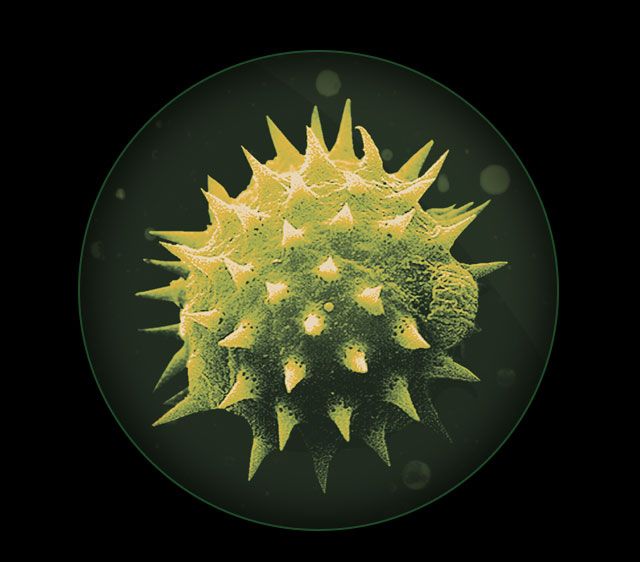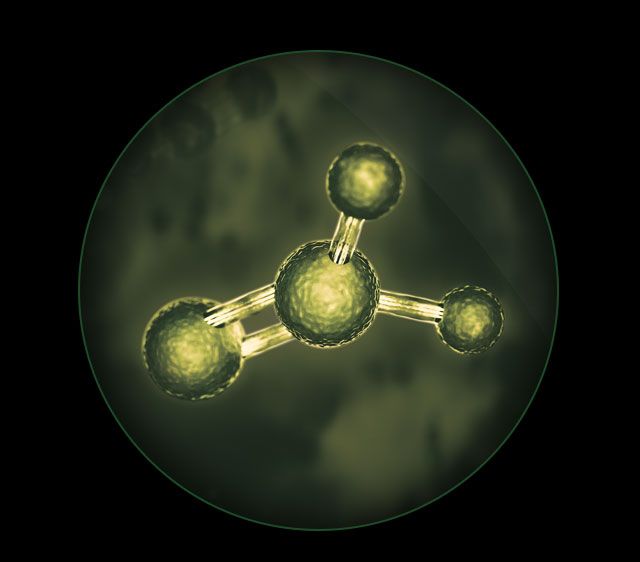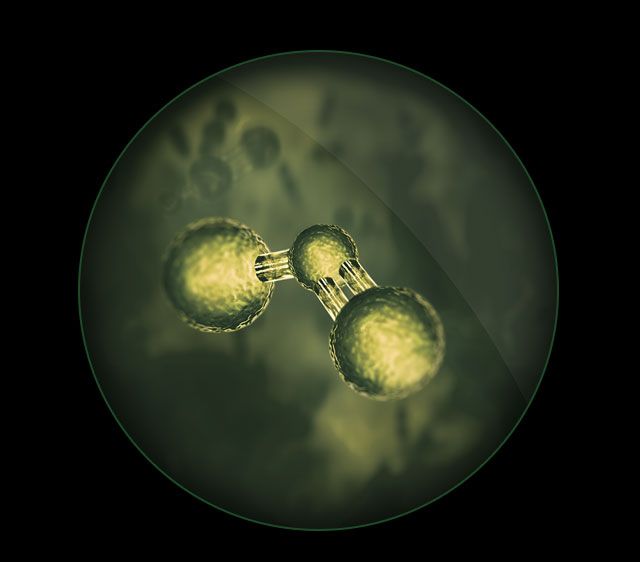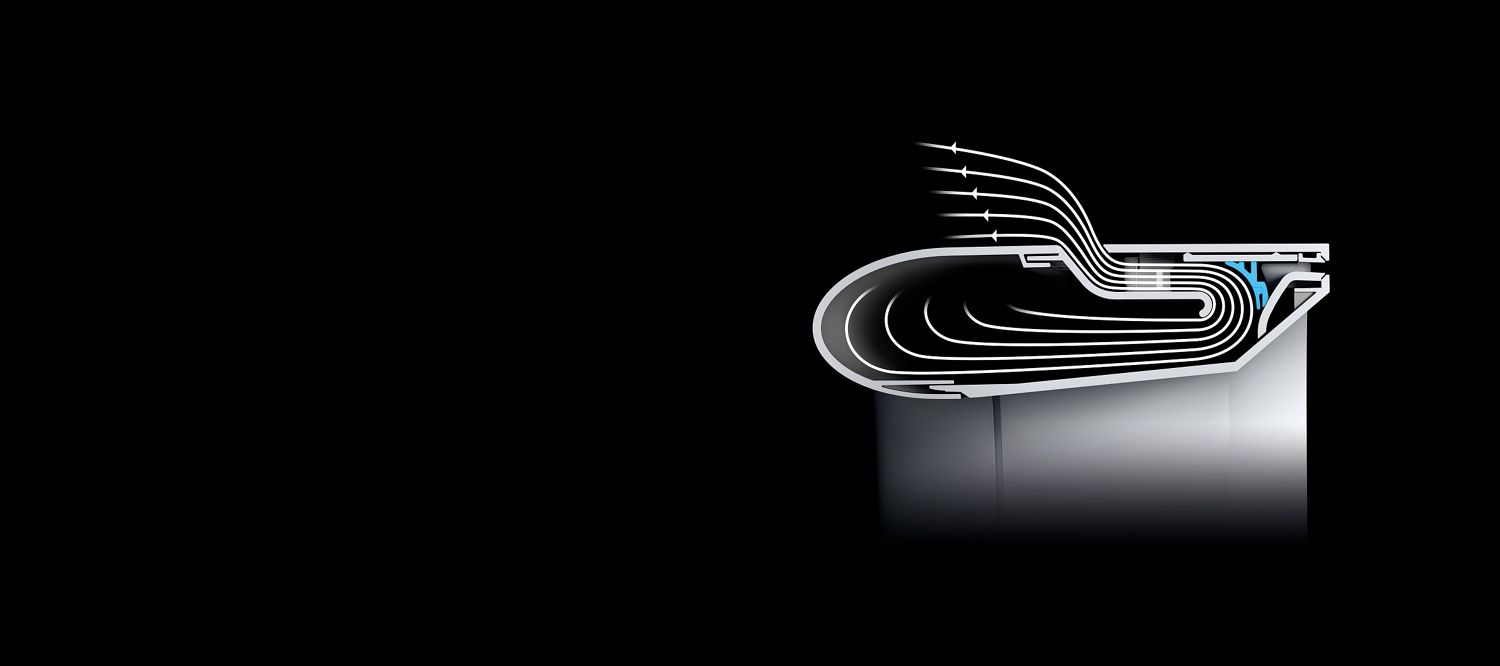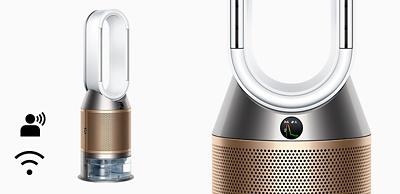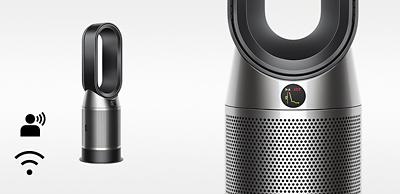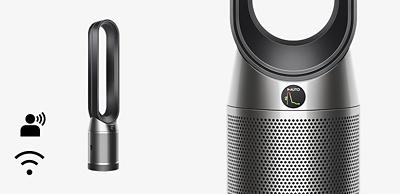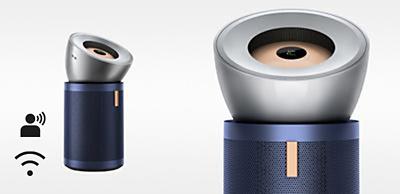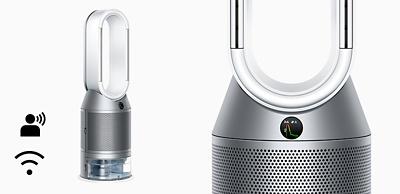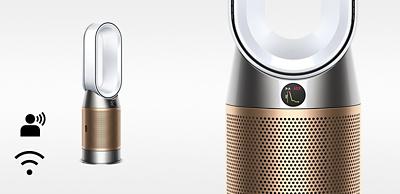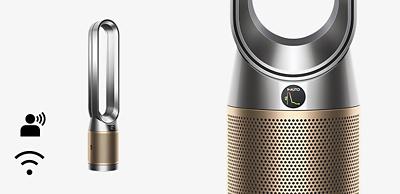
Pure Cool™ Technology
Filter technology
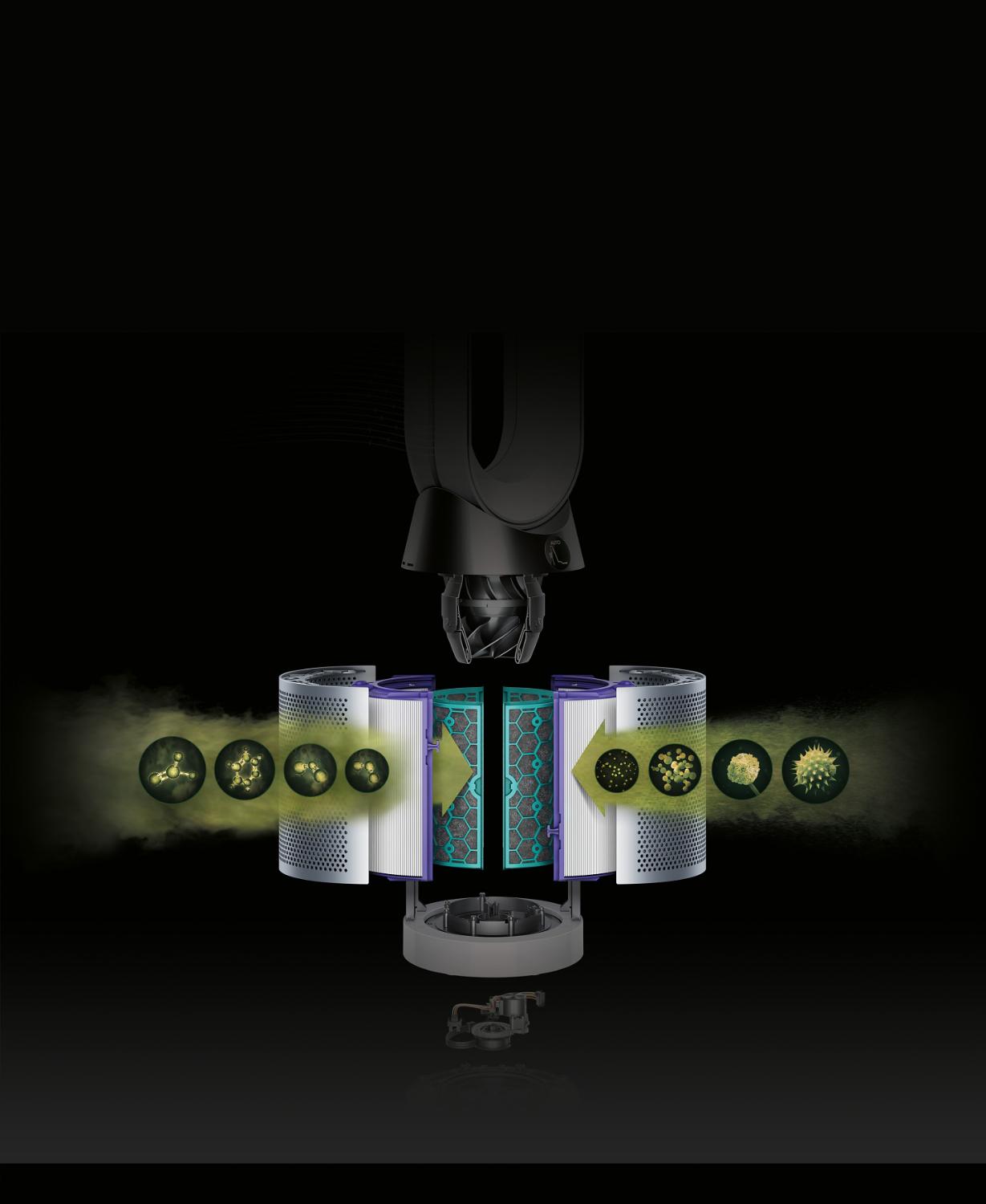
360° sealed filtration – removes gases and particulates.
The fully-sealed filter system combines an activated Carbon filter to remove gases, and a Glass HEPA filter that captures 99.97% of microscopic allergens and pollutants as small as 0.3 microns.
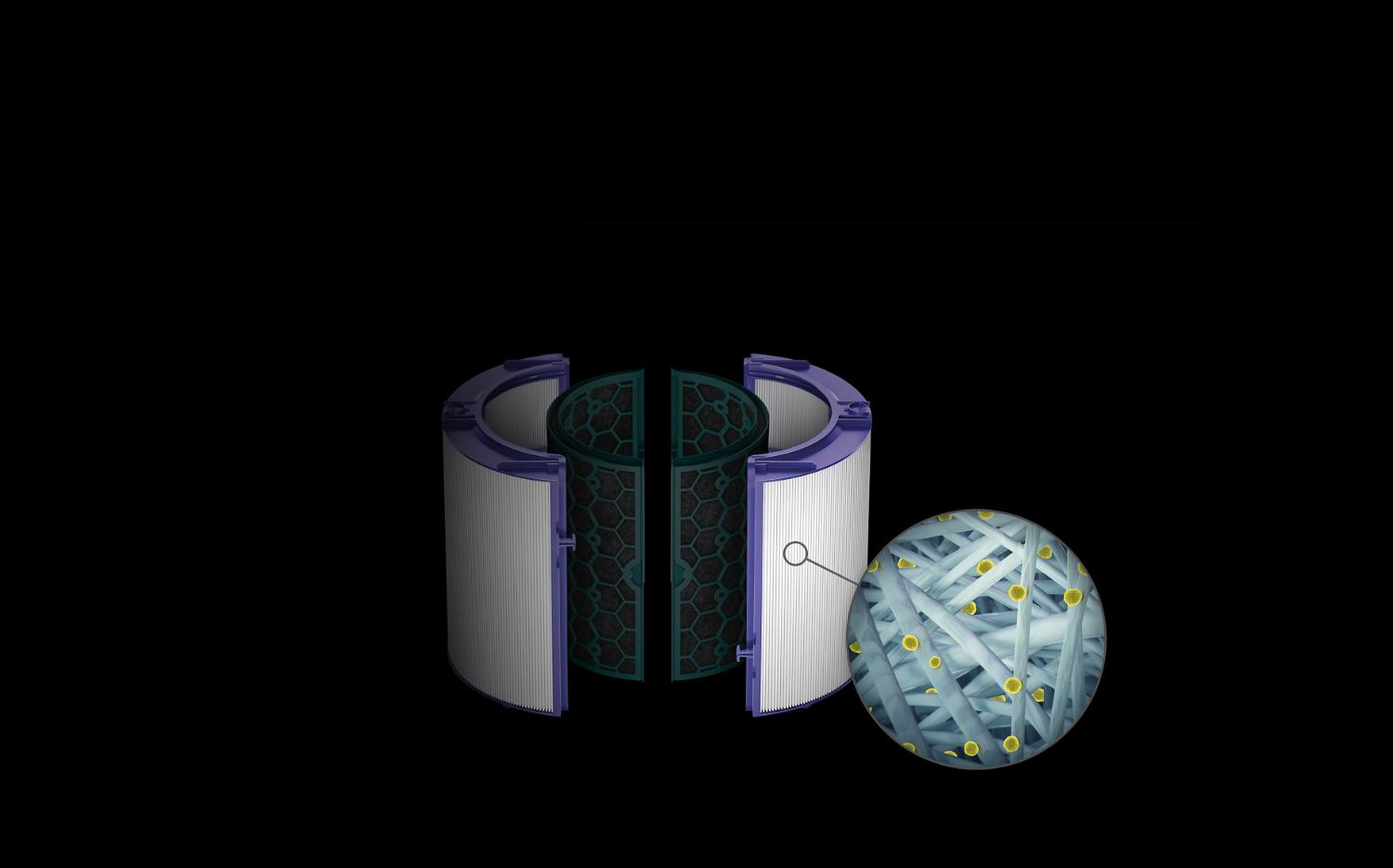
Glass HEPA filter.
9 metres of HEPA borosilicate microfibres, pleated over 200 times, to capture 99.97% of particles as small as 0.3 microns.
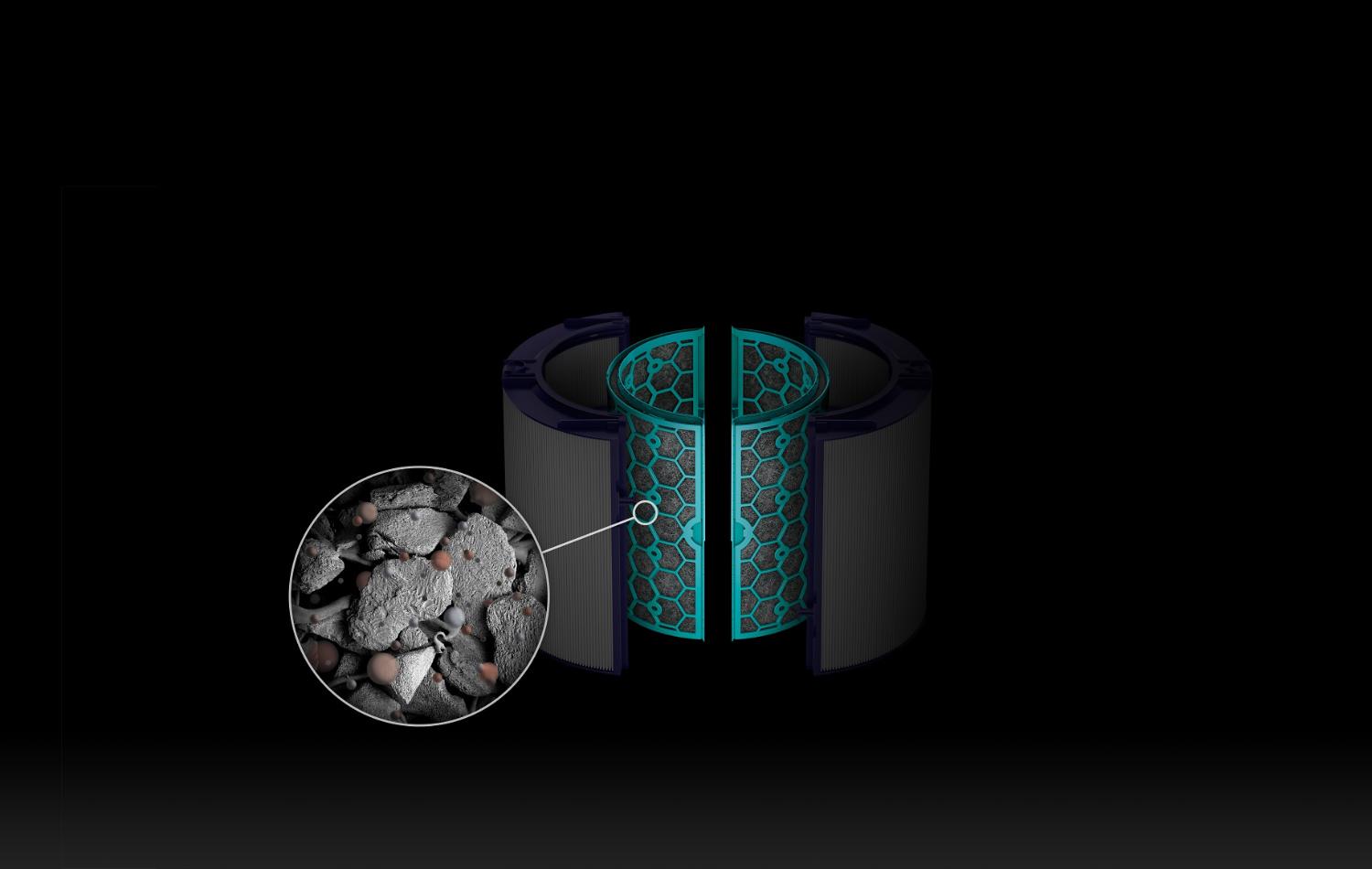
Activated carbon filter.
Tris-coated carbon granules capture gases such as formaldehyde, benzene and nitrogen dioxide.
Potentially harmful particles and gases can be found throughout the home. These include:
-

PM 10
Pollen and allergens
-

PM 5.0
Bacteria and
mould
-

PM 2.5
Industrial
emissions -

PM 0.3
Ultrafine particles
-

Formaldehyde
-

Ozone gases
-

Benzene
-

Nitrogen Dioxide
Using a unique algorithm, the Dyson Pure Cool™ purifying fan processes the input from three sensors to continually monitor the room air quality.
It uses this information to activate the machine and keep room pollution levels low.
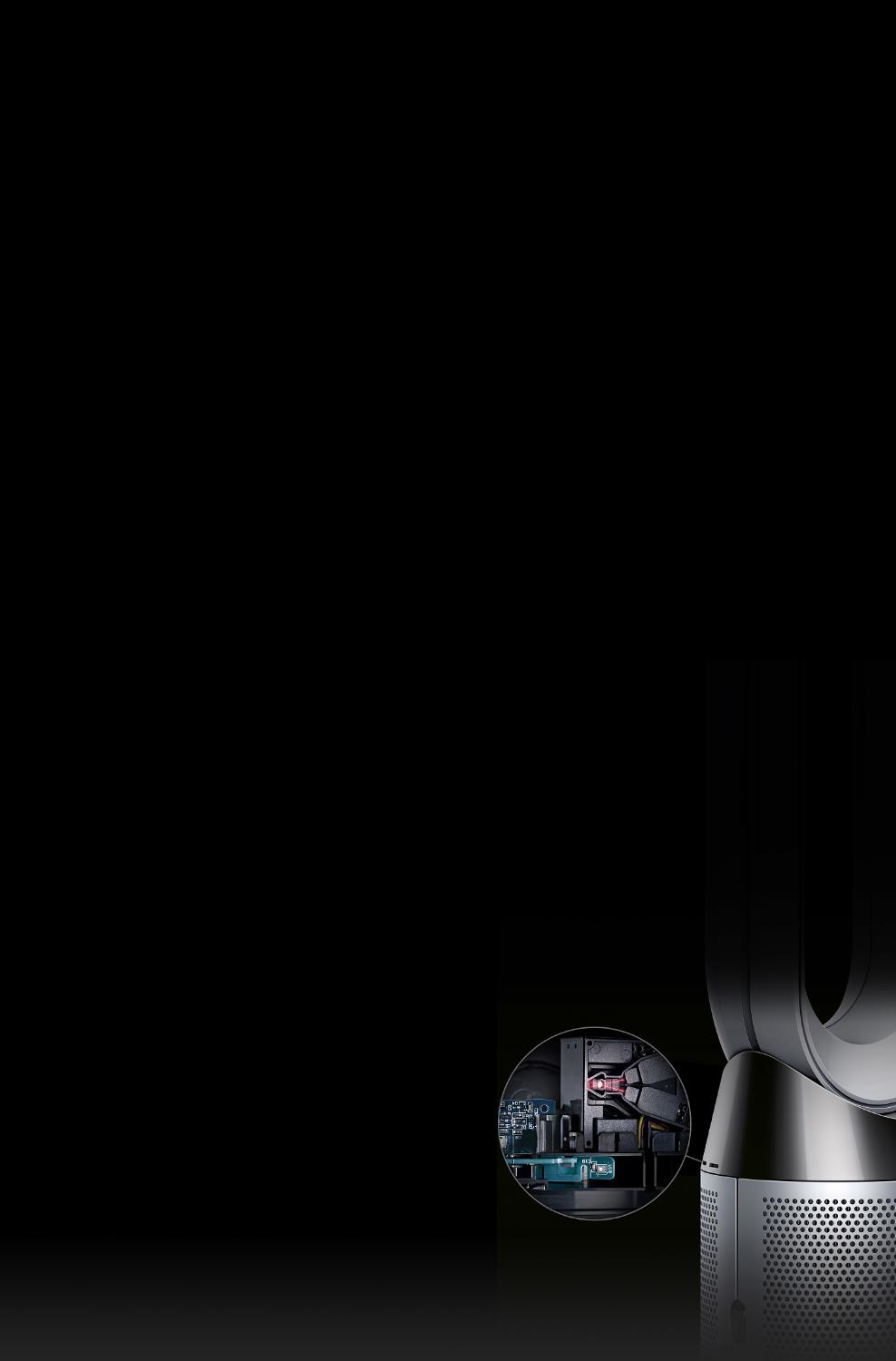
Particulate sensor
Uses laser measurement for constant particulate concentration analysis.
Gas sensor
Detects Volatile Organic Compounds (VOCs) and oxidizing gases such as NO₂.
Humidity and temperature sensor
Constantly monitors the relative humidity and temperature levels within the room.
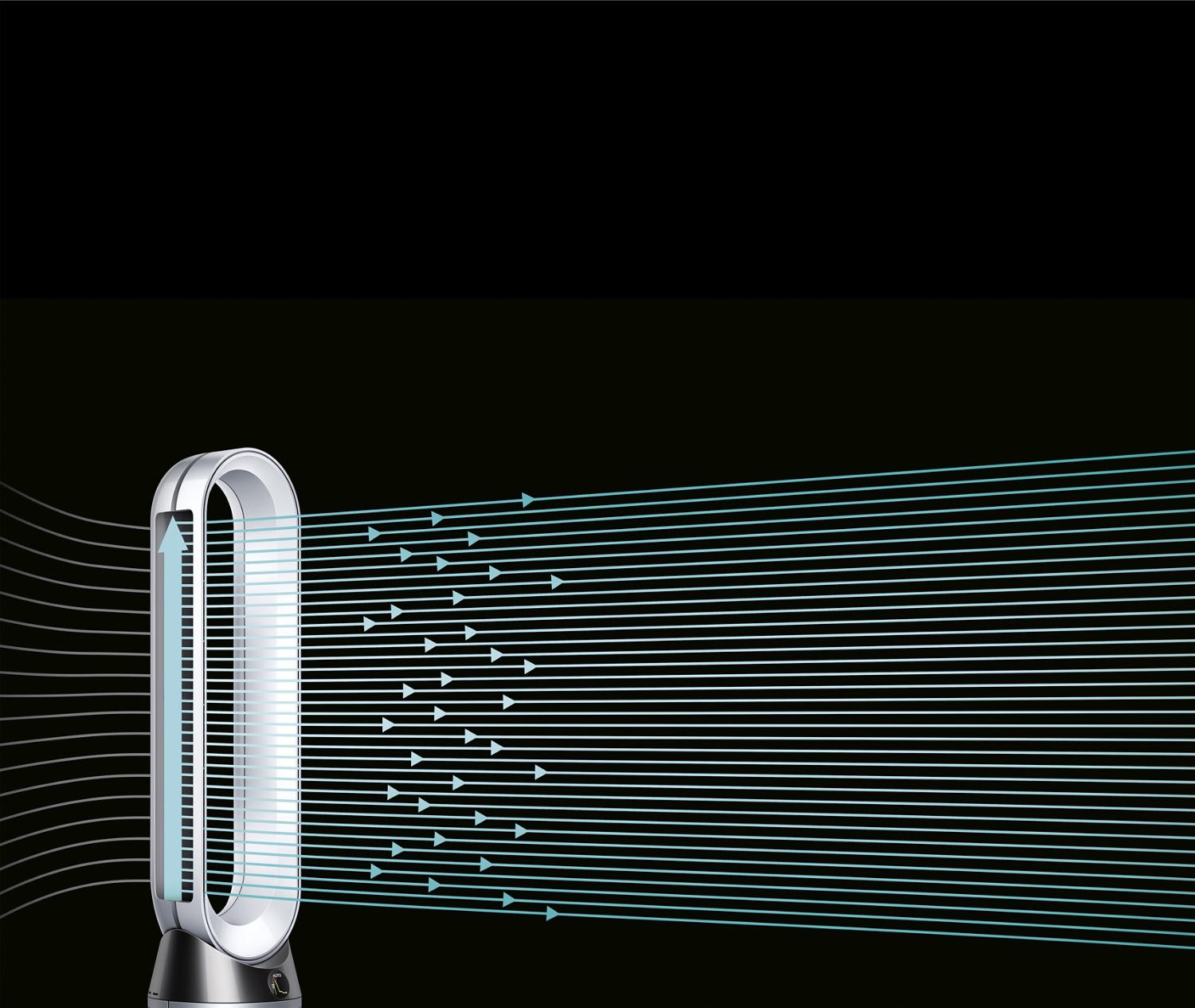
Powerful Air Multiplier™ technology.
Air Multiplier™ technology delivers over 290 litres per second of smooth, yet powerful airflow – circulating purified air throughout the whole room.¹
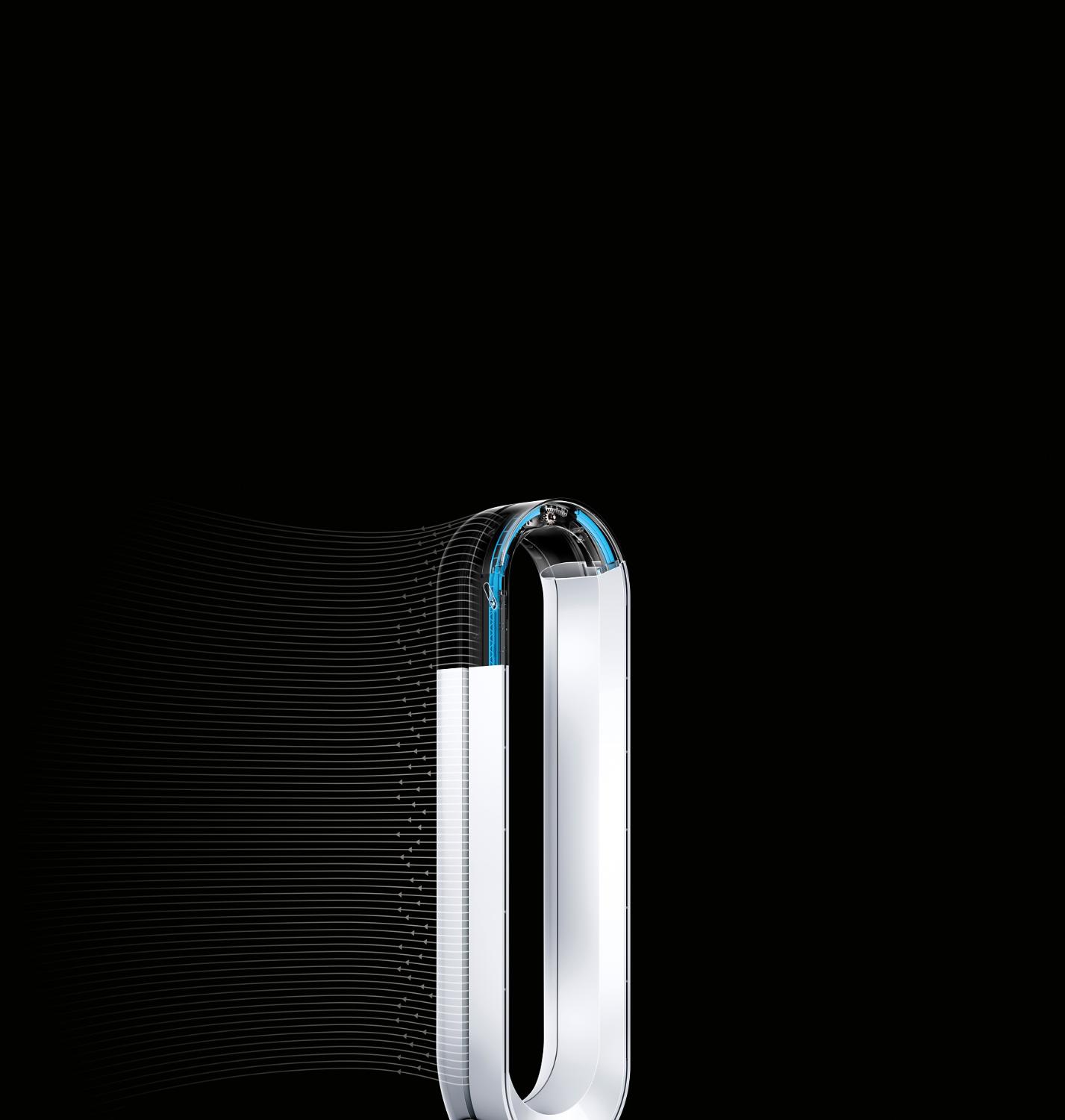
Two airflow modes.
An air valve mechanism is driven by a brushless stepper motor, to allow remote actuation and switching between Backward airflow mode and Fan mode. The stepper motor drives a pinion gear, which turns a rotational baffle driver around the arc of the amplifier. Angled slots in the baffle driver move the baffle forwards and backwards.
-

Forward projection
The baffle stays in place to deliver a forward powerful stream of purified air. -

Backward projection
The baffle moves to block the front aperture and diverts air through the rear of the annular at a 45° angle, creating a more diffused airflow. This uses less energy and is quieter because the aperture is wider. Purification effectiveness is still maintained, without the 'draft.'
Choose your model
Dyson Purifier Humidify+Cool Formaldehyde PH04 (White/Gold)
1823
Dyson Purifier Humidify+Cool Formaldehyde PH04 (White/Gold)
5
Star
1222
4
Star
234
3
Star
104
2
Star
64
1
Star
199
HEPA H13 purifier, humidifier and fan. Ideal for larger spaces.
Removes 99.97% of pollutants as small as 0.3 microns. Detects and destroys formaldehyde. Automatically senses and displays real-time air quality, humidifies your whole room and helps keep skin hydrated.
Only at Dyson: Exclusive technology and White/Gold colourway.
2 accessories included
See all Hide2 accessories included
See all Hide-
Remote control
Curved and magnetized to store neatly on top of the machine

-
360° Glass HEPA and Activated Carbon Filter
360 Combi Glass HEPA + Carbon air purifier 2-in-1 filter. We recommend replacing your filter every 12 months or when notified by your machine.

- Limited time only. While supplies last.
- Limited time only. While supplies last.
- Limited time only. While supplies last.
Dyson Purifier Big+Quiet Formaldehyde BP04 (Prussian Blue/Gold)
1420
Dyson Purifier Big+Quiet Formaldehyde BP04 (Prussian Blue/Gold)
5
Star
1223
4
Star
98
3
Star
26
2
Star
13
1
Star
60
Projects air over 32 feet to purify a large space.¹ Quietly.
Detects and destroys formaldehyde, permanently.⁴ Removes gases and odours.²
Only at Dyson: exclusive K-Carbon filter technology captures 3x more NO₂ ³, and CO₂ sensor reports CO₂ levels in real-time.
3 accessories included
See all Hide3 accessories included
See all Hide-
Remote control
Curved and magnetized to store neatly on the machine.

-
K-Carbon filter
Captures 3x more NO₂. Genuine Dyson Activated K-Carbon Filter lifespan is every 2 years or when alerted by the MyDyson™ app.

-
HEPA filter
Genuine Dyson HEPA Filter lifespan is 5 years.

- Limited time only. While supplies last.
- Limited time only. While supplies last.
- Limited time only. While supplies last.
Dyson Purifier Hot+Cool HP07 (Black/Nickel)
981
Dyson Purifier Hot+Cool HP07 (Black/Nickel)
5
Star
597
4
Star
146
3
Star
78
2
Star
55
1
Star
105
HEPA H13 purifier, fan and heater. Ideal for larger spaces. Removes 99.97% of pollutants as small as 0.3 microns.
Automatically senses and displays real-time air quality.
Only at Dyson: Exclusive Black/Nickel colourway.
2 accessories included
See all Hide2 accessories included
See all Hide-
Remote Control
Curved and magnetized to store neatly on top of the machine.

-
360° Glass HEPA and Activated Carbon Filter
360 Combi Glass HEPA + Carbon air purifier 2-in-1 filter. We recommend replacing your filter every 12 months or when notified by your machine.

- Limited time only. While supplies last.
- Limited time only. While supplies last.
- Limited time only. While supplies last.
Dyson Purifier Hot+Cool HP07 (White/Silver)
1035
Dyson Purifier Hot+Cool HP07 (White/Silver)
5
Star
632
4
Star
160
3
Star
80
2
Star
56
1
Star
107
HEPA H13 purifier, fan and heater. Ideal for larger spaces.
Removes 99.97% of pollutants as small as 0.3 microns.
Automatically senses and displays real-time air quality.
2 accessories included
See all Hide2 accessories included
See all Hide-
360° Glass HEPA and Activated Carbon Filter
360 Combi Glass HEPA + Carbon air purifier 2-in-1 filter. We recommend replacing your filter every 12 months or when notified by your machine.

-
Remote control
Curved and magnetized to store neatly on the machine

- Limited time only. While supplies last.
- Limited time only. While supplies last.
- Limited time only. While supplies last.
Dyson Purifier Cool TP07 (Black/Nickel)
1503
Dyson Purifier Cool TP07 (Black/Nickel)
5
Star
1114
4
Star
188
3
Star
71
2
Star
47
1
Star
83
Purifies the whole room¹ and cools you.
HEPA 13 filter captures 99.97% of pollutants as small as 0.3 microns. Connects to the MyDyson™ app.
Only at Dyson: Exclusive Black/Nickel colourway.
2 accessories included
See all Hide2 accessories included
See all Hide-
Remote control
Curved and magnetized to store neatly on the machine

-
360° Glass HEPA and Activated Carbon Filter
360 Combi Glass HEPA + Carbon air purifier 2-in-1 filter. We recommend replacing your filter every 12 months or when notified by your machine.

- Limited time only. While supplies last.
- Limited time only. While supplies last.
- Limited time only. While supplies last.
Dyson Purifier Big+Quiet Formaldehyde BP03 (Bright Nickel/Prussian Blue)
1420
Dyson Purifier Big+Quiet Formaldehyde BP03 (Bright Nickel/Prussian Blue)
5
Star
1223
4
Star
98
3
Star
26
2
Star
13
1
Star
60
Projects air over 32 feet to purify a large space.¹ Quietly.
Detects and destroys formaldehyde, permanently.⁴
Remove gases and odours.²
3 accessories included
See all Hide3 accessories included
See all Hide-
Remote control
Curved and magnetized to store neatly on the machine.

-
Activated carbon filter
Captures NO₂. Genuine Dyson Activated Carbon Filter lifespan is every 2 years or when alerted by the MyDyson™ app.

-
HEPA filter
Genuine Dyson HEPA Filter lifespan is 5 years.

- Limited time only. While supplies last.
- Limited time only. While supplies last.
- Limited time only. While supplies last.
Dyson Purifier Humidify+Cool PH03 (White/Silver)
224
Dyson Purifier Humidify+Cool PH03 (White/Silver)
5
Star
90
4
Star
46
3
Star
23
2
Star
21
1
Star
44
HEPA H13 purifier, humidifier and fan. Ideal for larger spaces.
Removes 99.97% of pollutants as small as 0.3 microns.
Automatically senses and displays real-time air quality, humidifies your whole room and helps keep skin hydrated.
2 accessories included
See all Hide2 accessories included
See all Hide-
Remote control
Curved and magnetized to store neatly on top of the machine.

-
360° Glass HEPA and Activated Carbon Filter
360 Combi Glass HEPA + Carbon air purifier 2-in-1 filter. We recommend replacing your filter every 12 months or when notified by your machine.

Dyson Purifier Hot+Cool Formaldehyde HP09 (White/Gold)
2012
Dyson Purifier Hot+Cool Formaldehyde HP09 (White/Gold)
5
Star
1355
4
Star
282
3
Star
126
2
Star
91
1
Star
158
HEPA H13 purifier, fan and heater. Ideal for larger spaces.
Removes 99.97% of pollutants as small as 0.3 microns.
Detects and destroys formaldehyde.
2 accessories included
See all Hide2 accessories included
See all Hide-
Remote Control
Curved and magnetized to store neatly on top of the machine.

-
360° Glass HEPA and Activated Carbon Filter
360 Combi Glass HEPA + Carbon air purifier 2-in-1 filter. We recommend replacing your filter every 12 months or when notified by your machine.

Dyson Purifier Cool Formaldehyde TP09 (Nickel/Gold)
2282
Dyson Purifier Cool Formaldehyde TP09 (Nickel/Gold)
5
Star
1750
4
Star
266
3
Star
77
2
Star
66
1
Star
123
Purifies the whole room¹ and cools you.
HEPA 13 filter captures 99.97% of pollutants as small as 0.1 microns.² Even destroys formaldehyde.³
Connects to the MyDyson™ app. Only at Dyson: Exclusive technology and Nickel/Gold colourway.
2 accessories included
See all Hide2 accessories included
See all Hide-
Remote Control

-
360° Glass HEPA and Activated Carbon Filter
360 Combi Glass HEPA + Carbon air purifier 2-in-1 filter. We recommend replacing your filter every 12 months or when notified by your machine.

Dyson Purifier Cool Gen1 TP10 purifying fan (White)
564
Dyson Purifier Cool Gen1 TP10 purifying fan (White)
5
Star
332
4
Star
90
3
Star
52
2
Star
24
1
Star
66
Captures dust, allergens and bacteria.
Whole-room purification. Cools you.
Control with remote. Not app compatible.
2 accessories included
See all Hide2 accessories included
See all Hide-
Remote control
Curved and magnetized to store neatly on top of the machine.

-
360° Glass HEPA and Activated Carbon Filter
360 Combi Glass HEPA + Carbon air purifier 2-in-1 filter. We recommend replacing your filter every 12 months or when notified by your machine.

Promotion
Direct from Dyson
Exclusive machines and offers
Exclusive Dyson machines, unique colour options and special gift editions, only available from DysonCanada.ca
Free shipping and returns
Free shipping and returns
What are my shipping options?
Standard shipping: Free
Shipping via Purolator or Canada Post is free of charge when ordering any new machine from the Dyson Store. We aim to deliver the machine(s) within 2-7 business days, subject to availability. Please note that there are a small number of postal codes, usually in remote rural areas, to which we may not be able to deliver within this timescale.
Expedited shipping: $25
If you need your machine in a hurry, we also offer an expedited shipping option via Canada Post to major cities – your order will be delivered within 2 business days. Simply switch to the expedited shipping option in the checkout. Please note that there are a small number of postal codes, usually in remote rural areas, to which expedited shipping is not available.
Accessories and Spare Parts: $5.99
Shipping for accessories and spare parts is $5.99. Orders will be shipped within 2-7 business days via Canada Post.
How long does shipping take?
Estimated delivery times to major cities:
Cities |
Standard Shipping (Free) |
Expedited Shipping: ($25) |
To Toronto |
2-5 business days |
2 business days |
To Ottawa |
2-5 business days |
2 business days |
To Montreal |
2-5 business days |
2 business days |
To Quebec |
2-5 business days |
2 business days |
To Winnipeg |
3 -7 business days |
2 business days |
To Halifax |
3 -7 business days |
2 business days |
To Calgary |
3-7 business days |
2 business days |
To Edmonton |
4-8 business days |
2 business days |
To Saskatoon |
3-8 business days |
2 business days |
To Vancouver |
4-8 business days |
2 business days |
To St.John's |
5-10 business days |
2 business days |
When will my delivery arrive?
Delivery is Monday to Friday 9am – 6pm local time, not including statutory holidays. If a delivery cannot be completed (for example, if you’re not home), the carrier will leave a notification at your door indicating where you can pick up your order.
Dyson Canada will make every effort to process orders within this timeframe, but issues outside of our control, such as weather, may cause delays. Dyson Canada will not be held liable for shipping delays in those cases. To process orders within this timeframe, we may need to contact you to validate your credentials.
If ordering multiple products your order may be delivered in multiple shipments. This is to ensure that your order is delivered as soon as possible.
How do I track my order?
You will be sent a notice of shipment email with tracking information upon the shipment of your order.
Can I ship to a PO Box?
Shipping to PO boxes is not available due to package size restrictions.
Can I ship to a different address than my billing address?
Yes you can, however please note that different billing and shipping addresses may cause a slight delay in delivery time due to our order verification process.
What happens if I’m not home to receive my shipment?
Since a signature is always required, please try to make sure someone is home to sign for your package. The carrier will make one delivery attempt, and if nobody is available to sign for the package you'll have two options:
1) Contact your selected carrier to arrange for a second delivery attempt.
or
2) Pick up the package from your local Purolator depot or Canada Post office. In order to determine at which location your package is being held, look up the package using the tracking number shared via email or contact the carrier. Be sure to bring one piece of mail with your name on it and a government-issued ID when you pick up your order.
What happens if my order was ‘returned to sender’?
If your order is not picked up from your either your local Purolator depot or Canada Post office within the time listed on your delivery notice it will be returned to sender. In the event that this happens, please contact Dyson Canada via email at service@dysoncanada.ca or by phone at 1-877-397-6622.
How do I return a product?
Buy risk free with free 30-day returns
Purchases made directly from www.dysoncanada.ca, Dyson Demo Stores, or Dyson helpline are eligible for a full money-back. The Dyson outlet's refurbished machines are final sale and are not eligible to be returned.
If you wish to return any product purchased from the Dyson Store within the first 30 days, please contact us prior to returning via email at service@dysoncanada.ca or by phone at 1-877-397-6622.
Dyson will cover the cost for the return shipping of any new machines. We will email you a pre-paid return shipping label. Simply print and affix it to the outside of your return shipment, and contact Purolator to arrange for a pick-up or you can drop it off at your local depot.
If you have any queries regarding your order, please contact service@dysoncanada.ca or call us at 1-877-397-6622.
Purchases made directly from www.dysoncanada.ca, Dyson Demo Stores or Dyson helpline are eligible for a full money back return within 30 days of the original purchase date.
Pay by installments
Affirm (formerly known as PayBright) is one of Canada’s leading installment payment providers. When you use Affirm to pay at Dyson’s checkout, you can split your purchase into easy, automatic monthly payments. To use Affirm as your preferred payment choice at checkout.
1. Add items to your shopping cart as usual, and select Affirm as your payment method at checkout for orders between $100 and $15,000 (including taxes and shipping).
2. Get set up: Use your mobile phone number and email to set up your Affirm plan within 60 seconds. Subject to credit approval.
3. Confirm your payment plan with Affirm. Dyson will process and ship your order as usual.
4. Make monthly payments to Affirm while you enjoy your purchase.
Widest selection
Widest selection
DysonCanada.ca offers the widest selection of Dyson machines in Canada, including the latest technologies and newest machines.
Some products are unique to DysonCanada.ca, so in buying direct you can feel confident in finding the right machine for you.
¹In max setting. Tested for whole room coverage (TM-003711 & DTM801) in a 290ft² room.
*Terms and conditions apply. Click here to see full terms and conditions.

